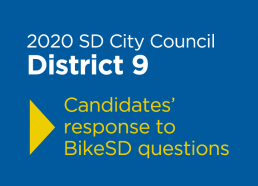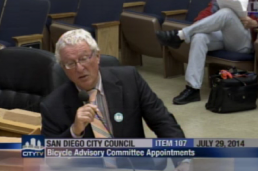2020 City Council Questionnaire - District 9: Alston, Barrios, Elo, Gade, Lee
Candidate: Sean Elo —
1) What are your top 3 priorities for improving the biking experience in District 1 for residents and families?
1. The construction of the Orange Avenue bikeway
2. Improved roads, including filling potholes, creating more protected bike lanes, and better lighting
3. Programs to offer free bicycles to youth from low and middle-income families
2) San Diego’s Bicycle Master Plan needs updating and projects need prioritizing in order to create a complete bicycle network. A large number of street resurfacing projects need to be re striped with bicycle infrastructure. How would you propose to fund the full build-out of the bicycle network needed to achieve the Vision Zero goals and meet the Climate Action Plan mode share targets?
First, I would work to ensure San Diego is doing all it can to capitalize on funding made available via federal, state (e.g. SB1), and regional legislation and initiatives. Included in the effort to capitalize on existing funding would be an increased emphasis on dedicating staff to pursue grant opportunities, especially those related to goals and plans the city has agreed to.
Second, I would be open to pursuing additional sources of revenue, whether through fees or a new dedicated funding stream. Essential to this route is creating widespread community buy-in through proactive engagement. I am a firm believer that the public is willing to invest in big, bold ideas that are dreamt up in partnership with community.
3) Transportation is the largest source of San Diego’s greenhouse gas emissions (55%). The City’s Climate Action Plan bicycle mode share goals are 6% of commuter trips by 2020 and 18% by 2035, from about 1% today. What steps will you take to make sure these goals are met or exceeded?
I support our city’s Climate Action Plan. My priority is to ensure these plans are effectively implemented. This implementation should put every idea on the table to address the global climate crisis.
There are multiple levers that must be pulled for us to reach the mode share goals necessary to meet our GHG reduction targets. First, we must make cycling safe for everyone who wants to ride. Second, we must prioritize and incentivize planning and development that makes cycling a reasonable transportation option for more people. Simply put, we need folks to live closer to where they work, shop, and go to school. Finally, we need to develop a generation of cyclists by putting more young people on bikes. The free bicycle program mentioned above would do just that while addressing transportation inequity.
4) Safe bike lanes often face opposition due to slower road speeds or reduced street parking. How would you work with the community to address concerns without compromising safety or delaying bike infrastructure in the name of consensus?
The first time I rode to Tijuana. It was my first month living in San Diego and I just thought it was the coolest thing that I could hop on my bike and ride to the border. Cycling was my primary mode of transportation at that point in time, but there was something special about that first trip.
Candidate: Kevin Alston —
1) What are your top 3 priorities for improving the biking experience in District 9 for residents and families?
Develop a plan to design Bike lanes that connect All of San Diego.
Rationale: As your councilman, I will work with transportation professionals, urban planners, architects, and private developers to get their input on how to implement the improvements in cycling conditions so desperately needed to reduce the dangers of cycling in San Diego County. Those efforts will require me to coordinate with my fellow council members, state, and federal government officials. Public policymakers at all levels must not only provide the necessary funding for better bicycling facilities but also adopt and implement a range of policies to encourage more compact, mixed-use development that naturally permits and encourages cycling as a part of daily life.
Traffic Signals with Bicycle Detection
Rationale: San Diego is reinventing its roadways to move more people, more safely and efficiently through the city, and as your elected official, I will work to complete networks that offer people more options to get around town in the ways that meet their day-to-day needs safely.
Offer “Free” Bicycle Safety Courses through the Community Colleges
Rationale: Bicycle repair workshops can be found in a variety of locations. Since college students typically comprise a larger-than-average cycling population, many short-term bike repair or maintenance courses are sponsored by colleges and universities on a non-credit basis. Community organizations, such as Bicycle Inter-Community Action and Salvage (BICAS), provide bicycle repair courses to the community as a means of promoting sustainable transportation (www.bicas.org). Additionally, bicycle shops often sponsor bicycle repair and maintenance courses for the general riding public.
Here is an outline of common concepts taught in bicycle repair courses:
- Chain, gear and brake repair
- Flat tire maintenance
- Hand-on experience
- Wheel truing and repair
- Bicycling tours
- Terrain familiarity
- Building workshops
2) San Diego’s Bicycle Master Plan needs updating and projects need prioritizing in order to create a complete bicycle network. A large number of street resurfacing projects need to be restriped with bicycle infrastructure. How would you propose to fund the full build-out of the bicycle network needed to achieve the Vision Zero goals and meet the Climate Action Plan mode share targets?
There have been funds allocated for building out San Diego infrastructure and I will ensure it is used as the citizens expected! I will create an action committee through my staff to research alternative funding for the bike lane project.
Also, corporate and private funding is an option. Groups dedicated to Bicycle safety would rally around the City’s need to improve Bicycle safety and would more than likely augment the existing city budget. As an incentive, I could lobby for naming Bike Lanes after the donators.
3) Transportation is the largest source of San Diego’s greenhouse gas emissions (55%). The City’s Climate Action Plan bicycle mode share goals are 6% of commuter trips by 2020 and 18% by 2035, from about 1% today. What steps will you take to make sure these goals are met or exceeded?
Educate the public through info-commercial, social media campaigns explaining the need to pressure our elected official to support the City’s Climate Action Plan bicycle mode. The promotional materials should include the benefits for improving conditions for bicycling in our cities is vital for San Diego’s public health. The fact is that bicycling would not only reduce pedestrian and cycling fatalities and injuries but also allow millions of people, many of them dangerously overweight, to bike or walk for some of their short trips and thus obtain healthful exercise in the course of daily life. More cycling would yield further public health benefits by reducing the use of automobiles, thus diminishing air and noise pollution and the overall level of traffic danger.
4) Safe bike lanes often face opposition due to slower road speeds or reduced street parking. How would you work with the community to address concerns without compromising safety or delaying bike infrastructure in the name of consensus?
It is important to package safety-enhancing programs in a way that dramatizes their benefits to everyone. The most obvious benefit would be the reduced risk of death and injury from cycling. The safety issue must be brought home to San Diego residents by public campaigns emphasizing the direct impacts on individuals, their families, and their friends. Improved safety also would encourage more people to cycle on a regular basis, providing them with valuable exercise, mobility options, independence, and even fun.
I will build a coalition of experts with public health officials because we should be working together with bicyclist and pedestrian advocates, traffic engineers, urban planners, environmentalists, architects and private developers, community leaders, and government officials at all levels. The public health community has the most potential to encourage the necessary changes at the grassroots level. Unless individual people can be convinced that they will directly benefit from better cycling conditions, politicians are unlikely to support the necessary policies. Self-interest is likely to be the strongest motivation to effect changes in travel behavior. Getting enough physical exercise is quite literally a matter of life or death. Health care professionals must convince their patients that walking and cycling on a regular basis for daily travel will help them live longer and healthier lives.
5) Please share a memorable experience(s) you have of bicycling.
My fondest memories from my childhood of bicycling was in Coney Island. As a New Yorker, we never grew up with a car, we relied on public transportation and bicycling. My friends and I would cycle all over Brooklyn from sunrise to sunset, and never realized the distances we traveled. We just enjoyed the freedom bicycling allowed teenager to experience. Now my two adult children take me on trips that involve cycling to our destinations and then explore areas of San Diego that you can only get to through bike lanes. I really enjoy how bicycling transports me and my kids to back nature through off-road trails and inner-city explorations.
Candidate: Kelvin Barrios —
1) What are your top 3 priorities for improving the biking experience in District 9 for residents and families?
My top 3 priorities to improving the biking experience in District 9, well in a nutshell is improving the biking experience in San Diego.
1) We need to complete bike corridors, that will get you across town without having to worry about a break in bike paths or ride through regular traffic
2) We need safe bikeways, protected lines would be best and ideal, bike signal lights and improved roadway, I would also advocate for MTS to include more bike racks like other transit agencies have done.
3) I would advocate for a set yearly allocation of funds to complete our unfunded bikeway projects, streamline permitting process and work hand in had with SANDAG on their bikeway projects.
2) San Diego’s Bicycle Master Plan needs updating and projects need prioritizing in order to create a complete bicycle network. A large number of street resurfacing projects need to be restriped with bicycle infrastructure. How would you propose to fund the full build-out of the bicycle network needed to achieve the Vision Zero goals and meet the Climate Action Plan mode share targets?
We currently have a good amount of funds set to go to improving roads, the city should take into account how to better connect our different bike lanes when bidding out road repair projects, that way we don’t have fragmented bike lane striping around the city, but better yet, we should do a yearly review of our San Diego Bicycle Master Plan and where we are at in implementing the projects and adjust as needed for new projects. The city needs to work better with SANDAG and be true partners to fund and permit our bikeway projects. I have seen first hand how the City has at times slowed down good bikeway projects that SANDAG has been proposing, but I have also been on the other side, where we along with community bike activist have slowed down a project to improve it. The orange-howard bikeway project is a good example of that.
3) Transportation is the largest source of San Diego’s greenhouse gas emissions (55%). The City’s Climate Action Plan bicycle mode share goals are 6% of commuter trips by 2020 and 18% by 2035, from about 1% today. What steps will you take to make sure these goals are met or exceeded?
Currently the sad truth is that the City is not doing enough to meet our mode shift goals, I am a strong advocate that we need to do more, we need to do better. I will propose a plan that will actually track our shift from cars to bikes, and layout milestones we need to reach in order to truly make progress on this. We need to team up with SANDAG on the tracking, and MTS on accommodating and being more bike friendly. We have to talk to each other on the different government agencies if we are to do this right and also push back when we are not seeing enough progress.
4) Safe bike lanes often face opposition due to slower road speeds or reduced street parking. How would you work with the community to address concerns without compromising safety or delaying bike infrastructure in the name of consensus?
I’ll be honest, I am not a fan of saving parking spots at all cost. It’s backwards thinking, we need to plan for the future, and sometimes that means making some scarifies right now to have a better tomorrow. In order to meet our CAP goals we need to be more aggressive. With that being said, there are ways to minimize parking loss, but let’s not do it at the expenses of the project… it does little to really encourage people to ride bikes if all we are doing is a simple paint job and not protected lanes, with bulb outs and cutways for bikes ect.
5) Please share a memorable experience(s) you have of bicycling.
I have many, I really enjoy bicycling, Back when I was working as a Transportation Policy Advisor for Councilmember Gomez I would ride my bike to work a few times a month. I loved going through Pershing Ave into downtown. There was that time where we rode our bikes with community folks to the University Ave Bikeway Project open house, we rode down University to really experience how unsafe that was and how much we really needed a safe bikeway project there. There was also a fun day where Georgette and I rode our bikes together to a community event she was speaking at, we both live in City Heights and decided to bike instead of drive to the event.
Candidate: Andrew Gade —
I would like to thank you for your hard work in regards to Bike SD. I believe that is very important to continue to look at ways to expand the network of protected bike and pedestrian lanes. San Diego definitely needs to update our Bicycle master plan. We need to balance parking and residents concerns along with completing a full city wide bike network. I have a utility overlap proposal that will help coordinate all road and infrastructure work to incorporate bike and pedestrian right of ways. If nothing else, I can guarantee I will do everything in my power to best represent San Diegans needs and protect our future.
Candidate: Johnny Lee —
I am not seeking PAC endorsement or funding. I am simply answering your questions.
Some people say they care about the environment, but the truth is they really don't. Some people say the care about the environment, and yet they still have a car and drive. I don't have a car, I get around by getting rides, biking, using my hover craft, walking, and Uber/Lyft.
I have a lot of fond memories of biking, I haven't had a car in 4 years.
1. Going along dedicated bike lanes, along creeks, are relaxing, safe and convenient.
2. Going around in circles on my bike, realizing I have no reason I need to go straight to where I need to go, and taking my time.
3. Being amazed at myself to be able to get to the other side of town, faster than a car during rush hour traffic, and always much faster than a bus.
4. Going up a mountain with a bike that doesn't have gears.
5. Going up mountains for no reason with my crazy biker friends, with a bike with gears. Peddling real fast, but not going anywhere fast.
6. The leader of my biking club getting hit by car. When he gave me biking lessons in, he told me don't worry about using the full lane, "we have the right of way". I told him, "You're crazy, get out of the road". One month later, he was hit by a car.
7. Remembering how stupid the bike lanes were, to be located on the busiest streets in town, which are unsafe and slows down car traffic. I would go one street over, be in a residential street, and have a safe and convenient ride without ever using the bike lanes.
8. Remembering when I complained to the city about bike and pedestrian passages being closed off, making it impossible for bikers get to their destinations.
9. Almost getting hit by a car, several times, because I ignored the traffic signs.
10. Getting hit by tree branches while biking, they hurt a lot more than I expected.
11. Giving my bike away to a senior citizen. A senior citizen told me his bike was stolen. I gave him my bike.
12. Many more memories.
My top priority is to created dedicated bike lanes, mainly along the creeks, and making it circle the entire city, so people can use dedicated bike lanes, and not bike lanes on city streets.
I do NOT believe in bike lanes on city streets, I believe they are UNSAFE, and not needed since most major roads are parallel to residential streets. I really think it would be safer if bikers would take residential streets instead of the busy main streets.
Goal of 6% by 2020. Dreaming.. Dreaming.. Dreaming... Stop dreaming people. Is your purpose to improve the environment or make it safer and fun for bikers? I don't have a car myself, but I would never force other people to who have to dress up to get to work, or use a car for grocery shopping, or to pick up kids. There are seniors and disable people who need to drive to get where they want, and can not walk far. What are we doing, by getting rid of parking spaces, and intentionally slowing car traffic so that more people would use public transportation, is this to improve traffic or to fix the environment?
I worked in the bio-energy (renewable energy) industry for 7 years. I am a lead researcher in biomass energy conversion still today. I presented at the Department of Energy in 2017 about my biomass energy conversion research. I have a degree in biology. I realistically understand our environmental problems better than most people. Unlike some people who just talk. I put my money where my mouth is. I bike, I use public transportation and I work in renewable energy. I think we
are dreaming if we expect that slowing down traffic will cause more people to use public transportation. I believe that as a government, if you can not help people, than don't do anything to hurt them. And these bike lanes are doing just that. You and me, both know, these bike lanes in the city are completely unutilized and are slowing down traffic, and making life worse for drivers; and ultimately make it unsafe for bikers, which in the long run, make it less beneficial for people to bike.
And in the end, the environment is not improved.
Bike lanes, have nothing to do with the environment, and I think environmentalist should stay out of making bike lanes, and leave making bike lanes to bikers and people who want to protect bikers and not the environment.
With respect to the environment. I believe we should live in harmony with the planet, and that means living within our means, wanting less and using less energy. I believe that the whole planet is already working towards fixing the environment, and everywhere cars and electronics are becoming more efficient and using less energy. I want a whole world that runs on renewable energy, and even cars that are 100% environmentally friendly. If all cars are environmentally friendly, use less energy and run on renewable energy, what is wrong with cars then? This is the path, the entire world is working towards so that we can have a better environment, and I think the whole world is right. If we want to limit
transportation emissions, all we have to do is make cars more efficient and run on renewable energy.
Things are already going down this path. Bike lanes on busy roads will not help the environment, it is a dream to think that from 1% of people on public transport we are going to get everyone or even more than 2-3% on bikes and buses; the infrastructure is not there and logistically it is impossible.
I have a realistic plan to fix the environment and make biking safe and fun for everyone, and it does not involve forcing people to use public transportation and making their lives more inconvenient. I want to make life easier for people, our residents already have enough to worry about.
San Diego City Council Adopts City's First Bicycle Advisory Committee
Earlier this week, on Tuesday, San Diego's City Council unanimously approved the creation of the city's first Bicycle Advisory Committee. This was a goal that was originally proposed in the 2002 city adopted bike plan, the city's second plan to accommodate bicycling.

Getting this committee established was one of our goals for our second year of existence (we launched as an organization in 2012). The composition of the committee calls for each Councilmember adopting one appointee and the two appointees made by the Mayor. Districts 4, 6, and 7 do not have a representative yet, so if you live in these neighborhoods now would be a nice time to get to know your elected representatives at City Council.
The current members of this new advisory committee include the following:
- Petr Krysl, involved with bicycling planning in UCSD where he is also a professor, representing District 1
- Nicole Burgess, who has been asking for improvements on Nimitz for as long as this website has been in existence, representing District 2
- Michael Brennan, the founder of San Diego Streets for People and a board member and a voice of reason at the Uptown Parking District representing District 3
- Kathleen Keehan, former executive director of the San Diego County Bicycle Coalition from 1999 to 2011, representing District 5
- Randy Van Vleck, Active Transportation Manager at the City Heights Community Development Corporation, representing District 9
- Andrew Hanshaw, current executive director of the San Diego County Bicycle Coalition and founder of Bike the Bay, representing District 3
- Kyle Heiskala, who led a successful student fee referendum at UCSD for bus and light rail access representing District 3
- and myself, Samantha Ollinger, representing District 8.
If you're not sure what all the District numbers mean, here is a link to a neat map that visually shows the entire city and its council districts.
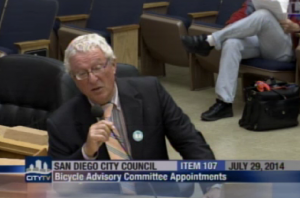
At the Council session on Tuesday, the item to approve the committee was scheduled to be on the consent agenda (essentially voted on without any discussion), however frequent Council Chambers visitor and occasional mayoral candidate, Steven Greenwald, asked for the item to taken out of consent and open for discussion. He was the only member of the public who spoke about the item and he spoke in support of it. He voiced support for "designated bike lanes" and asked that the city look to Vancouver for inspiration. He also talked up bike trains, which Nicole Burgess has been leading in Ocean Beach, and Veronica and Sandra have been leading in Mid-City. Greenwald also mentioned that not all drivers were "sensitive to the fact that bicycles have a place in transportation".
All councilmembers provided positive comments.
Marti Emerald (District 9) stated that perhaps even she could one day be on a bicycle, but that she was "petrified" to ride in traffic today.
Mark Kersey (District 5) thanked Kathy Keehan for her willingness to serve.
Sherri Lightner (District 1) thanked Petr Krysl for his willingness to serve.
Lorie Zapf (District 6 and soon to be District 2) thanked the entire group of committee members and recalled her experience of riding with Burgess and spoke about the needed changes to accommodate the upcoming bike share program as well and changes at Nimitz Boulevard and where the I-8 meets the dog park.
David Alvarez (District 8) spoke about the Climate Action Plan and commended the current District 2 staff that ride to their jobs at City Hall.
Ed Harris (interim Councilmember in District 2) seemed a bit surprised that the issue of bicycling had made a dent at City Hall and made generally positive comments as well.
Scott Sherman (District 7) spoke about the positive effects of seeing more people on bicycles.
Todd Gloria (District 3) stated that this was simply a formalization of the work that all of us had done to date. He also mentioned that the work done in the city to date were "modest" but wanted to see work sped up. Gloria also mentioned that the bike share program was scheduled to launch on October 30th this year. Gloria emphasized that this committee would be working with city staff to advise them on the work that needed to be done.
Emerald made a motion to approve the creation of the Bicycle Advisory Committee and newly re-elected Councilmember of District 2 (to be seated in November) Lorie Zapf seconded the motion.
Foto Friday: Kensington Community Church Encourages Biking to Church
Last month was Bike Month, and one Friday was devoted to encouraging people to bike to work. But people travel by bicycle to places besides work. At least one local church, Kensington Community Church, is encouraging San Diegans to bike to church as evidenced by the prominent placement of three bike racks in front of the church.
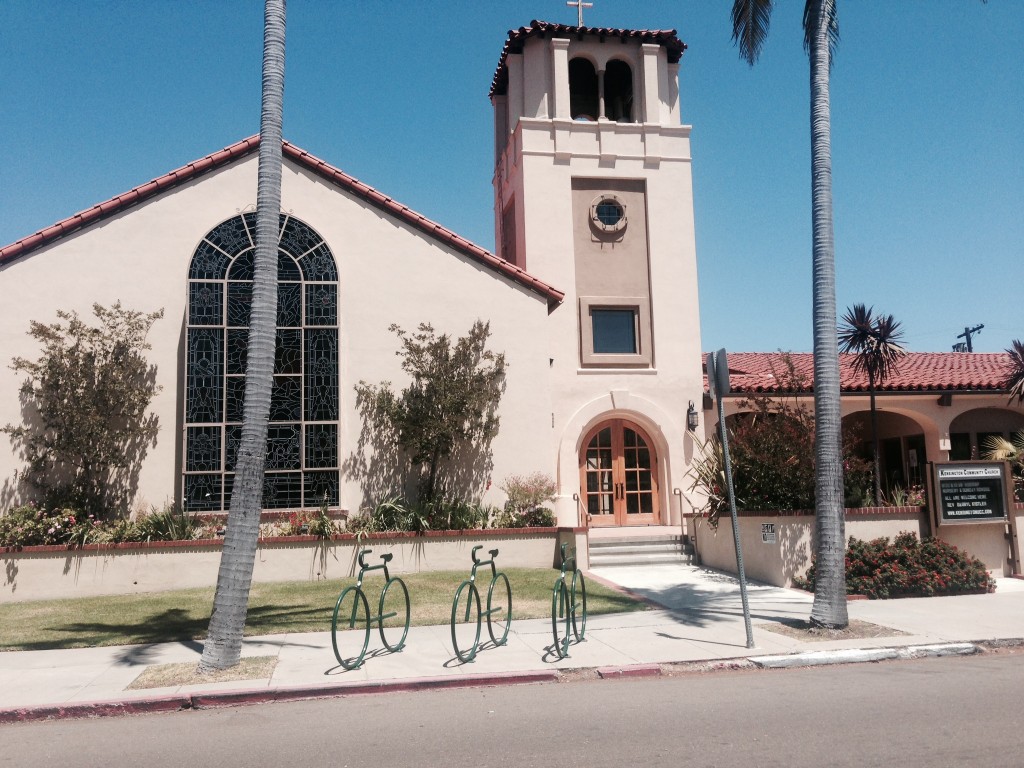
Kensington Community Church's Pastor, Darryl Kistler, has demonstrated his support for bicycling and has been discussing improving and expanding transportation access, especially for bicycling, for at least a year now. This is the sort of good leadership that all San Diegans need to bear witness to.
If you want to request a bike rack to be placed in front of your favorite venue, don't hesitate to contact the city.
For the Mid-City Community: Three Decades of Broken Promises
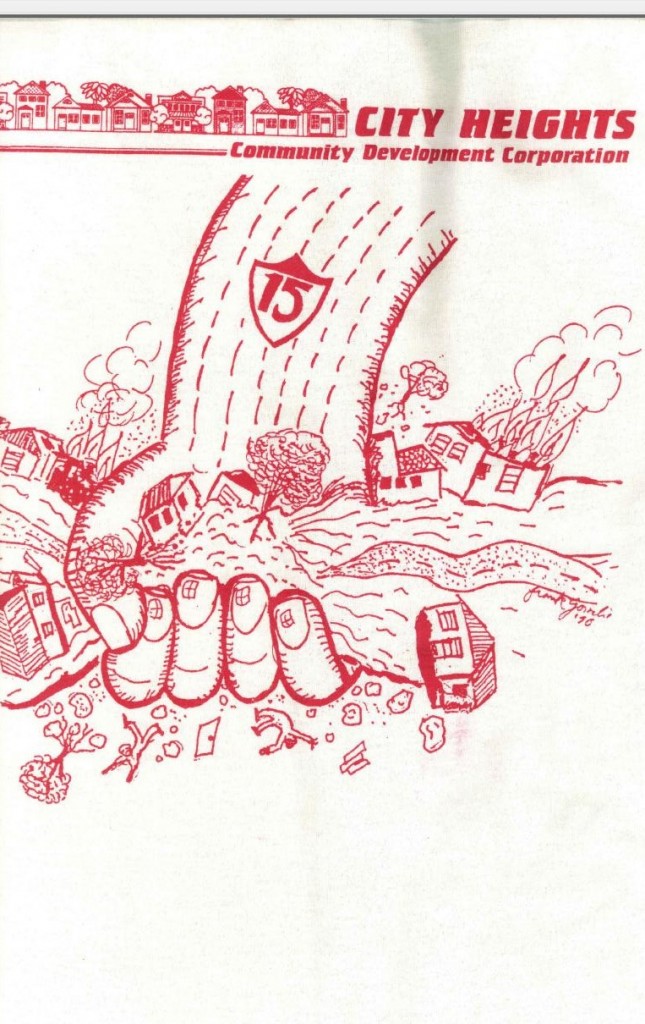
In late 1972, the California Department of Transportation (Caltrans) released a report detailing the impact that would result after the construction of I-15 (from I-805 to I-8, approximately 3 miles) through the heart of Mid-City, specifically the neighborhood of City Heights:
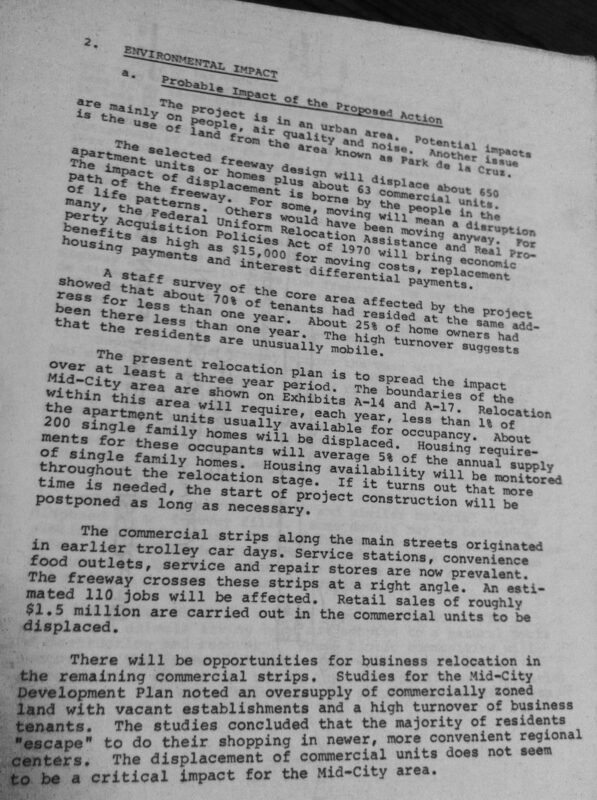
The project is in an urban area. Potential impacts are mainly on people, air quality and noise. Another issue is the use of land from the area known as Park de la Cruz.
The selected freeway design will displace about 650 apartment units or homes [Ed. note: displacing 2,000 people plus about 63 commercial units affecting 110 jobs and $1.5 million in annual taxable retail]. The impact of displacement is borne by the people in the path of the freeway. For some, moving will mean a disruption of life patterns. Others would have been moving away. For many, the Federal Uniform Relocation Assistance and Real Property Acquisition Policies Act of 1970 will bring economic benefits as high as $15,000 for moving costs, replacement housing payments and interest differential payments.
The report goes on to state:
The displacement of commercial units does not seem to be a critical impact for the Mid-City area.
Using logic that only a highway focused agency could come up with, the report goes on:
Exhaust emissions will be concentrated along the Route 15 corridor. Future traffic that would have used city streets or other highway routes will use the freeway. People working or residing along Route 15 will have better air quality after the freeway is constructed. However, this will be due to vehicle emission controls and the passage of time. It probably will not be due to the freeway.
Under the Federal Clean Air Amendments of 1970, the San Diego Air Basin will have to meet national ambient air quality standards by 1975. The freeway projects will not be completed in time to have any effect in meeting the 1975 deadline. By today's standards, 1975 and later vehicles will be essentially "pollution free". The number of pre-1975 models will decline with time; few will still be operating in 1986.
The report gets worse:
There will be noise impacts on the people remaining along the freeway corridor. From a community point of view, the freeway can probably be seen as a benefit. Noise levels at the closest homes will be lower than they are today. However, the people are not the same. Those living on the east side of Central Avenue, Terrace Drive and 39th Street will hear an adverse impact.
The destruction caused by the building of I-15 through City Heights may never fully be understood, but a documentary titled "The Price of Renewal" does give some light on the issue.
As depicted in The Price of Renewal, after the Caltrans announcement in the 1970s to build a freeway through City Heights, residents abandoned their homes and crimes began to rise contributing to a decline in overall quality of life.
Today, City Heights is finally turning a corner. After decades of advocacy by committed City Heights residents, the Centerline Bus Rapid Transit will finally be built (downgraded from a light rail line). Caltrans will finally be applying for funding to build the I-15 bike path from Adams Avenue to Camino del Rio South - fulfilling a promise made nearly three decades ago - that will connect the Mid-City Community to Mission Valley. And efforts are being made to eliminate the results of institutionalized neglect against a community made impoverished by former leaders too fixated on moving vehicles and building highways.

I do spend a considerable amount of time thinking about people like James D. Knochenhauer, the Regional Representative at the Bureau of Community Environmental Management, who in 1971 wrote a letter stating that the I-15 project wouldn't cause "any problems of health significance".
Today City Heights residents experience higher rates of asthma (than residents in the rest of the county) and a lack of access to transportation options despite only a third of the residents having access to an automobile.

I do wonder if individuals like Mr. Knochenhauer thought about the community of City Heights and how his letter of support contributed to decades of decline in a once vibrant and thriving community.
I wonder if he ever regretted writing that letter.
More on this topic here and here thanks to San Diego Free Press.
New, Wider Bike Lanes Installed on Montezuma Road's North Side
If any of you were complaining about the lack of love for bicycle facilities on the north side of Montezuma Road, rest easy. Robert Craddick sent in photo documentation of the newer wider bike lanes complete with painted buffers that went in earlier this month.
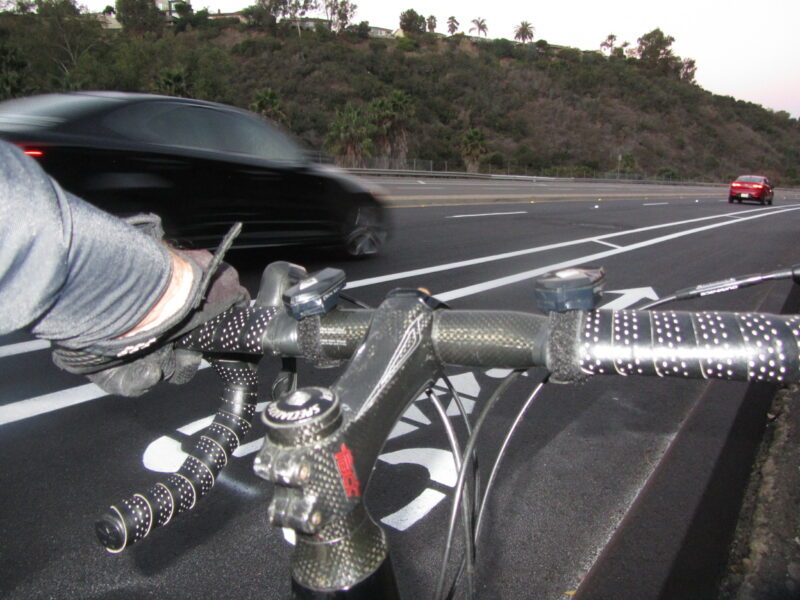
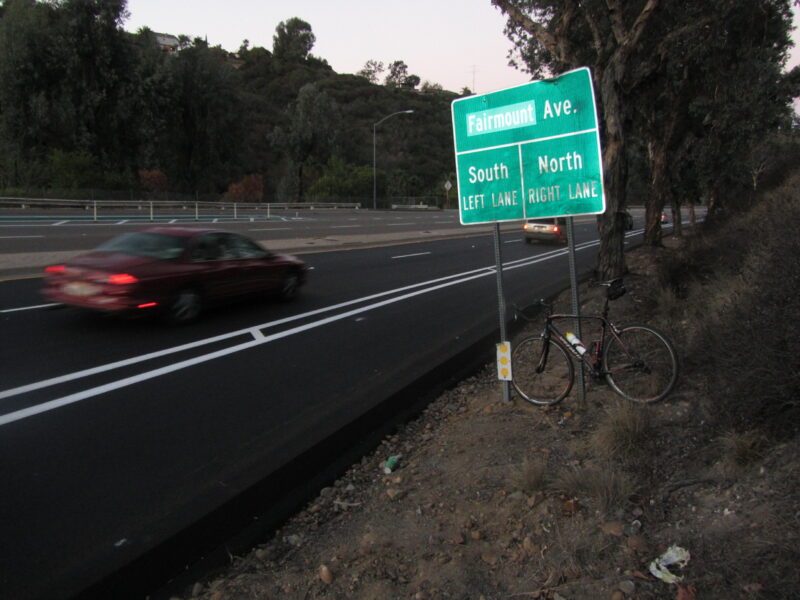


Have you had a chance to check these new bike lanes out? What did you think?
Craddick offered this comment: "Really nice job!"

